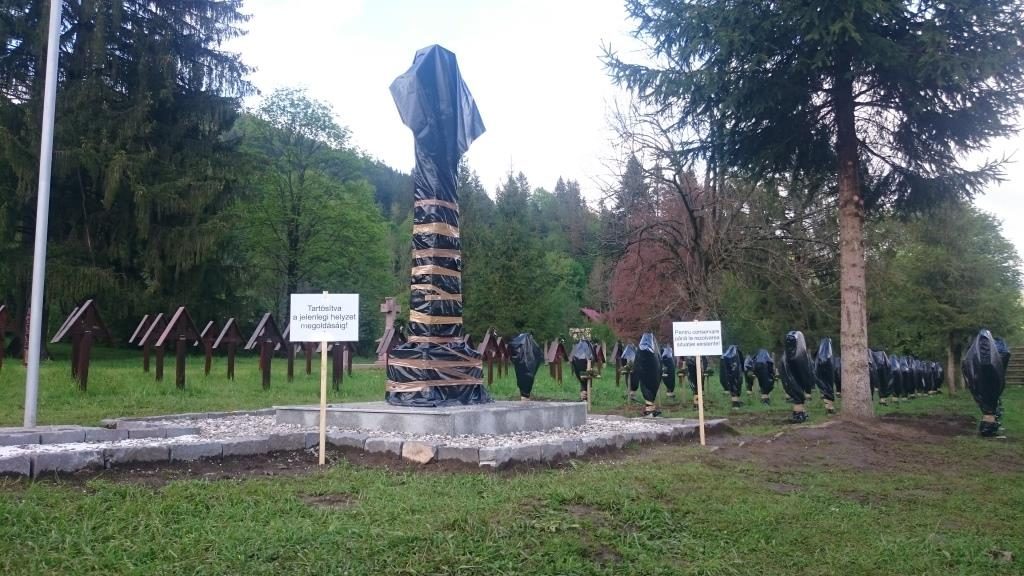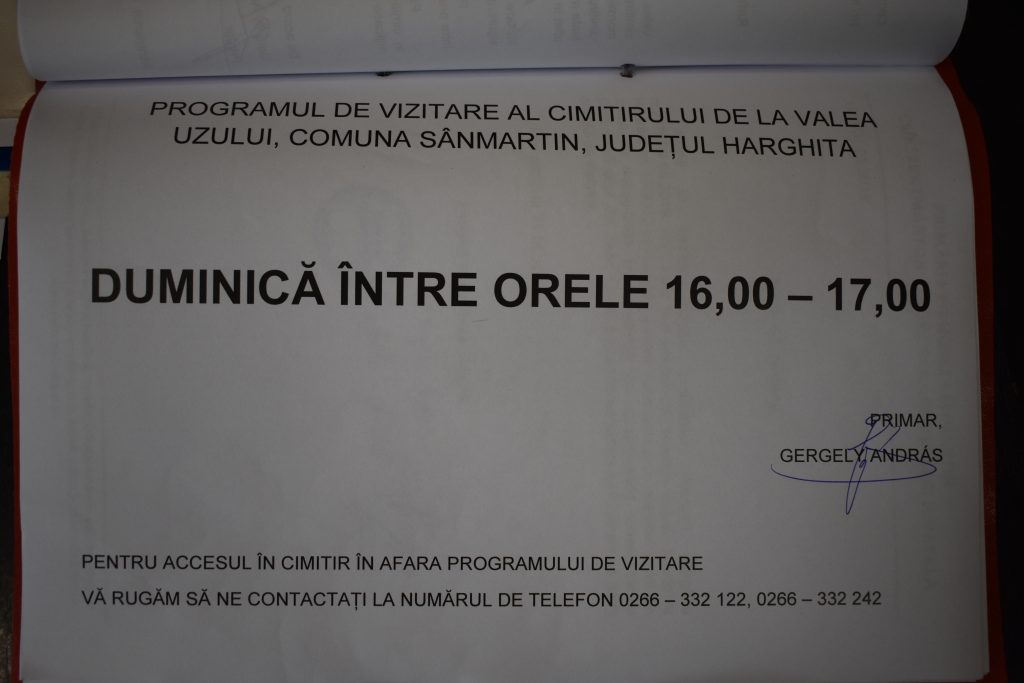This is the story of how an unsolved border dispute between two settlements (Csíkszentmárton / Sânmartin Ciuc and Dărmănești) turned abruptly for the worse when the mayor of Dărmănești took unilateral action based on questionable documents. It shows how ethnic conflict in the region can provoke tensions that then lead to irreversible impact on both the Hungarian and Romanian communities. The series of events also raises troubling questions about double standards in the Romanian judicial system. Read also Part I, Part II, Part III and Part V.
Inauguration postponed, border dispute remains
On May 12, 2019, thousands have gathered and prayed for the Úz Valley graveyard during the ecumenical worship organized on the site. “What’s interesting, though, is that on May 12, when the Harghita County Council organized the ecumenical worship in the Úz Valley cemetery, it was required by law to notify the gendarmerie in time about the event. However, at that time, the Harghita County Gendarmerie said that it wasn’t competent in this matter, but the Bacău County Gendarmerie is. So we notified them as well. However, after the scandal in the Úz Valley, the Harghita County Gendarmerie again became competent on the matter and fined me for failing to notify them in time about the demonstration,” Csaba Borboly told Transylvania Now.
A civilian action group sends an erroneous message to the wrong recipient
A civilian action group calling themselves Úzvölgyi Civil Akciócsoport, led by Andrea Ladó, covered the illegally erected concrete crosses and memorial in black plastic foil and issued a Manifesto, on May 16, 2019. They also published a petition that they publish only in Hungarian, saying that “we have withdrawn from circulation the illegally erected crosses until the legal procedure [clarifying the situation in the Úz Valley cemetery] is finished.” The recipient of their action supposed to be the RMDSZ, but they failed to inform the Romanian community about it.

They filmed themselves during the action and posted a handful of pictures on Facebook showing the crosses covered with black plastic bags. The pictures spread like wildfire among Hungarians and Romanians alike. These are the pictures the majority of the Romanian mass media uses as headline images when reporting the case of the Úz Valley graveyard.
The plastic bags didn’t stay long on the concrete crosses, as a group of Hungarians arrived at the Úz Valley cemetery just seconds after the civil group left. They removed the plastics bags and documented the action with pictures, but those pictures aren’t published on the web. Transylvania Now has seen those images.
During the night of May 17, 2019, a group of Hungarians from Hungarian parties and NGOs organize a night watch of the cemetery, as they feared the Dărmănești local authority has changed its mind and will inaugurate the illegally erected memorial and Romanian parcel. Around 70–80 people are in front of the cemetery gate. There were no incidents during the night, only cars allegedly belonging to the Romanian authorities pass by and capture the people around the cemetery on camera.
The Romanian community doesn’t know that the crosses were erected illegally. The ethnic conflict card comes into play
The first reaction comes from the Romanian community following the civil group’s action. Since the election campaign is ongoing, a unionist EP candidate from Focsani, George Simion visits the cemetery and launches a Facebook live streaming. His tone is manipulative and provocative, and he seeks to get attention using the “ethnic card” to instigate ire between the Hungarian and Romanian communities, calling the Hungarians extremists and the like. He slips in the mud but says he was beaten by Hungarians while trying to access the cemetery. The video’s message is that Romanians aren’t allowed in the international cemetery to honor their heroes. Pictures of the young man accompanying Simion are posted on Facebook appearing to show signs of physical aggression on his face, and his left arm is tied up. The fake pictures are debunked very quickly: within 24 hours those signs disappear and, in another picture, he appears with his right arm tied up.
Surprisingly on May 23, 2019, the vice-mayor of Csíkszentmárton is taken in by police officers early in the morning, who appear at the door at 6:00 a.m. with a search warrant. The likely cause is a complaint to police by Simion after his provocative visit to the Úz Valley cemetery. On the same day, the RMDSZ decided to end support for the Romanian government over the graveyard issue. Seeing that the Úz Valley cemetery has become the scene of various questionable activities, the Csíkszentmárton local council decides to close the graveyard for 30 days. The decision didn’t last long: the Harghita County prefect attacks the decision in court, hence automatically suspended the scope of the decision.
In order to prevent additional troubles, the mayor of Csíkszentmárton, András Gergely, and the Harghita County Council’s president, Csaba Borboly, symbolically lock down the cemetery and post its new schedule, which limits the visiting hours to Sundays between 4 p.m. and 5 p.m., but it also lists two phone numbers for visitors to call if they arrive outside visiting hours. But the message that gets to the mass media is: Hungarians won’t let the Romanians inside the graveyard to honor their heroes.

Romanian authorities call on Dărmănești mayor to cease illegalities
The Bacău prefect called on the Mayor of Dărmănești to cancel construction license no. 69/2018 until June 7, 2019. The Dărmănești Mayor’s Office answers only on June 10, 2019 in a letter registered with no. 12641, saying that it maintains his point of view that both Urbanization Certificate (136/2018) and the construction license are legal.
On June 3, 2019, the Ministry of Defense denied Toma Constantin’s allegations that he had their support for the modifications issued in the Úz Valley graveyard. It also highlighted that every modification to the cemetery (and every military cemetery) requires approval from ONCE. The organization that works under the MoD has not issued such approval for the Úz Valley graveyard since 2004. But that didn’t stop the mayor to finish his plan: on the same day, the Dărmănești mayor’s office sets the new date for the inauguration ceremony: June 6.
On the same day, the Bacău prefect called on the Dărmănești Mayor’s Office to revoke the local council’s decision no. 29/2019. The mayor’s office has to comply with it before June 25, 2019, otherwise the prefect threatens with a lawsuit.
Shortly after the inauguration day is announced by Dărmănești, a series of Romanian extremist groups announce they have approval from the Mayor’s Office to organize their event at the Úz Valley cemetery. In other words: to participate at the highly awaited inauguration of the Romanian parcel in the Austro-Hungarian cemetery. The organizations affiliated with far-right politics and ideologies are: Frăția Ortodoxă “Sfântul Mare Mucenic Gheorghe, Purtătorul de Biruință, Organizatia Astra Carei, Noua Dreapta, “Sfântul Mare Mucenic Gheorghe Aducătorul de Biruinţă”, Asociația Națională Cultul Eroilor “Regina Maria” Bacău, Asociatia Calea Neamului Brasov, Asociatia pt Civilizatia Ortodoxa ASCIOR, Asociatia pentru Toleranta in Spatiul Public, Asociatia pentru Scut Botosanean, Asociatia Transilvana pentru Literatura Romana si Cultul Poporului Roman – ASTRA, Asociatia Ajuta Oamenii Prahova, Asociatia Dacii Liberi, Asociația Calea Neamului. This is just a partial list of the “associations” present in Úz Valley on that ominous day.
Click here to read part V.
Read also Part I, Part II, Part III.
Title image: uniform wooden cross in the Úz Valley military graveyard. Photo: István Fekete